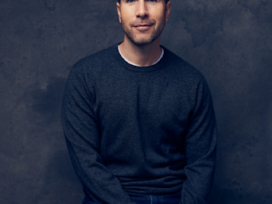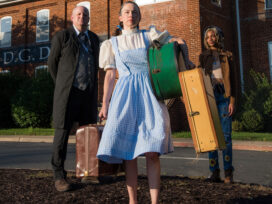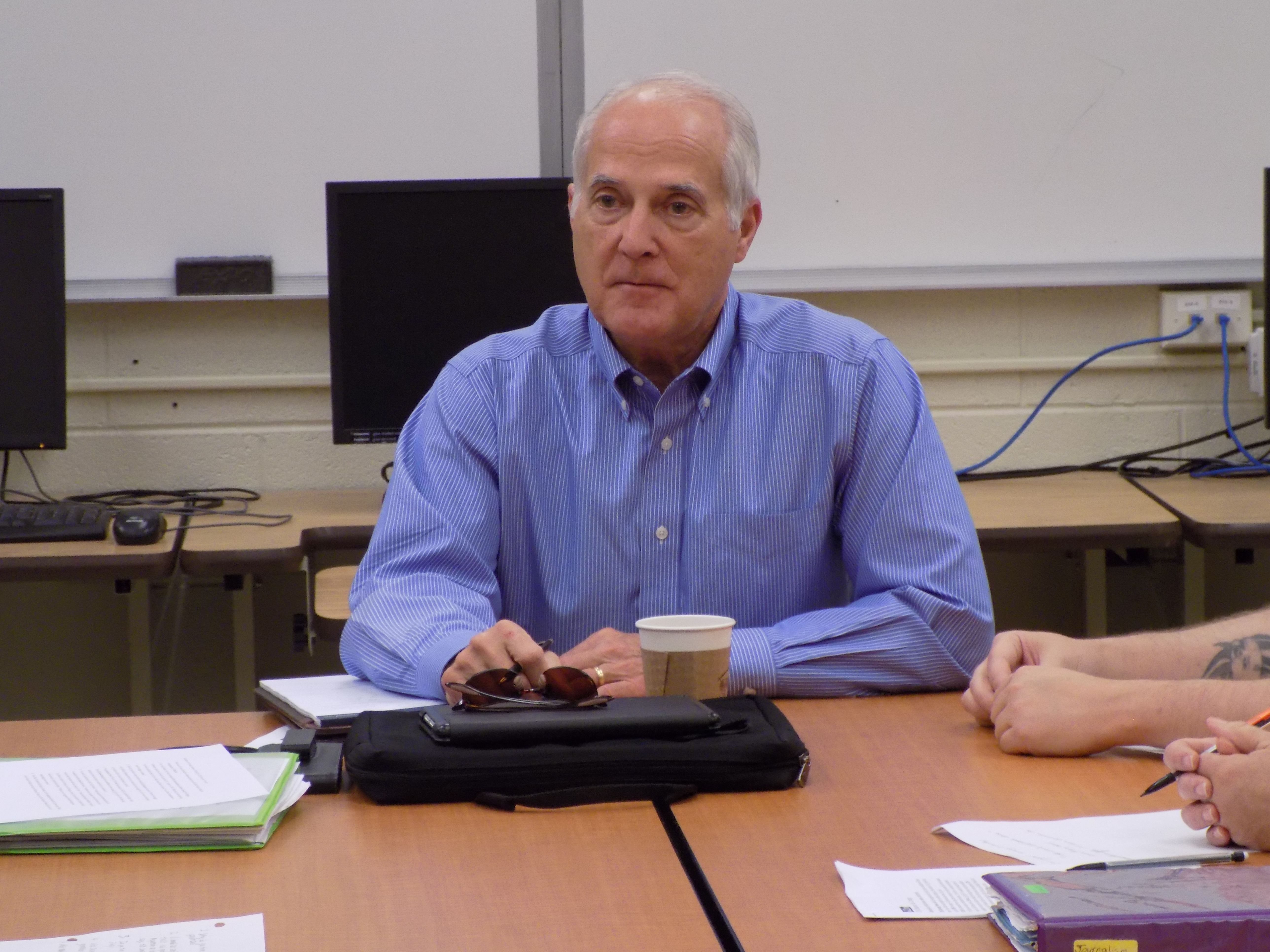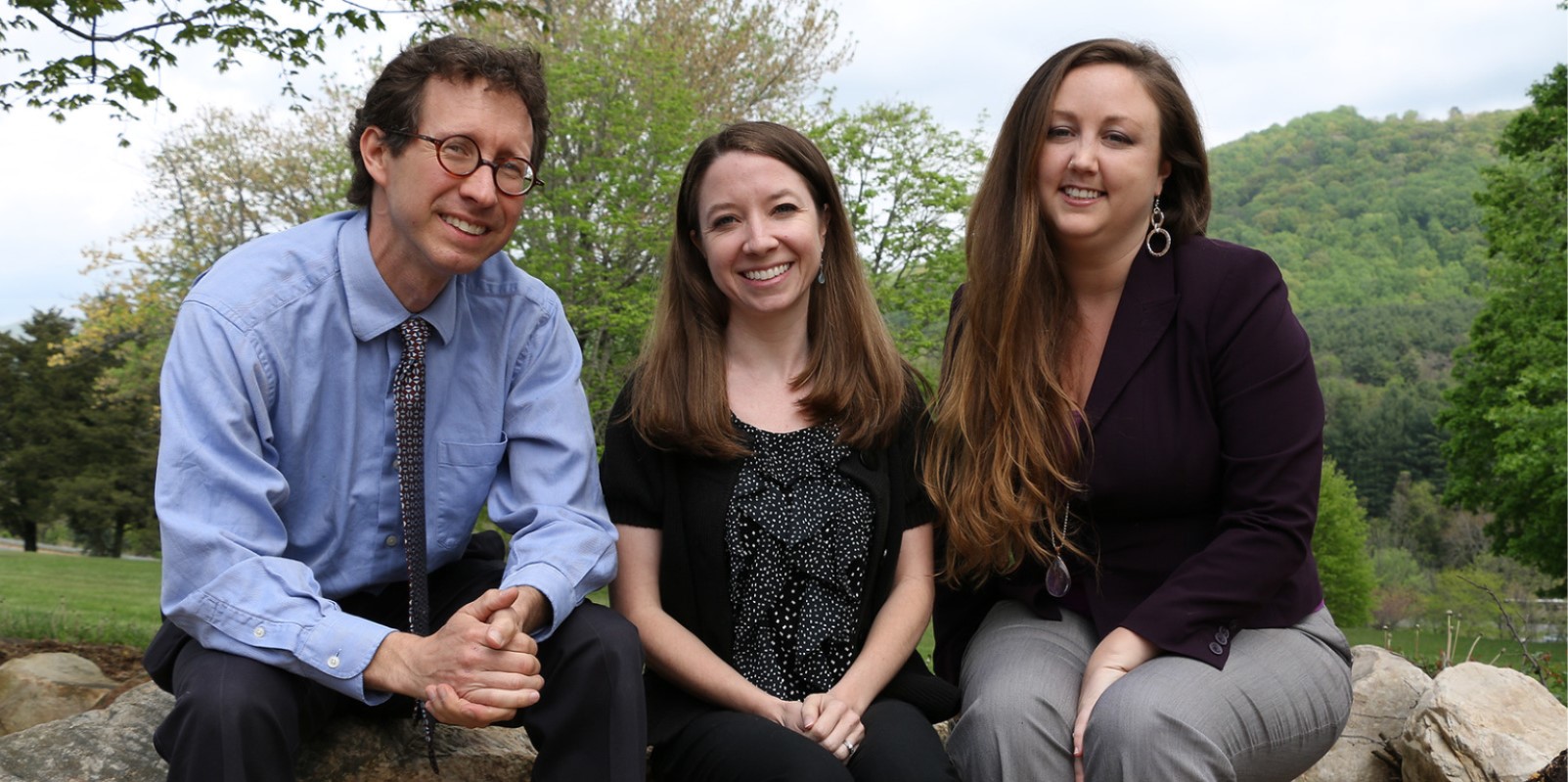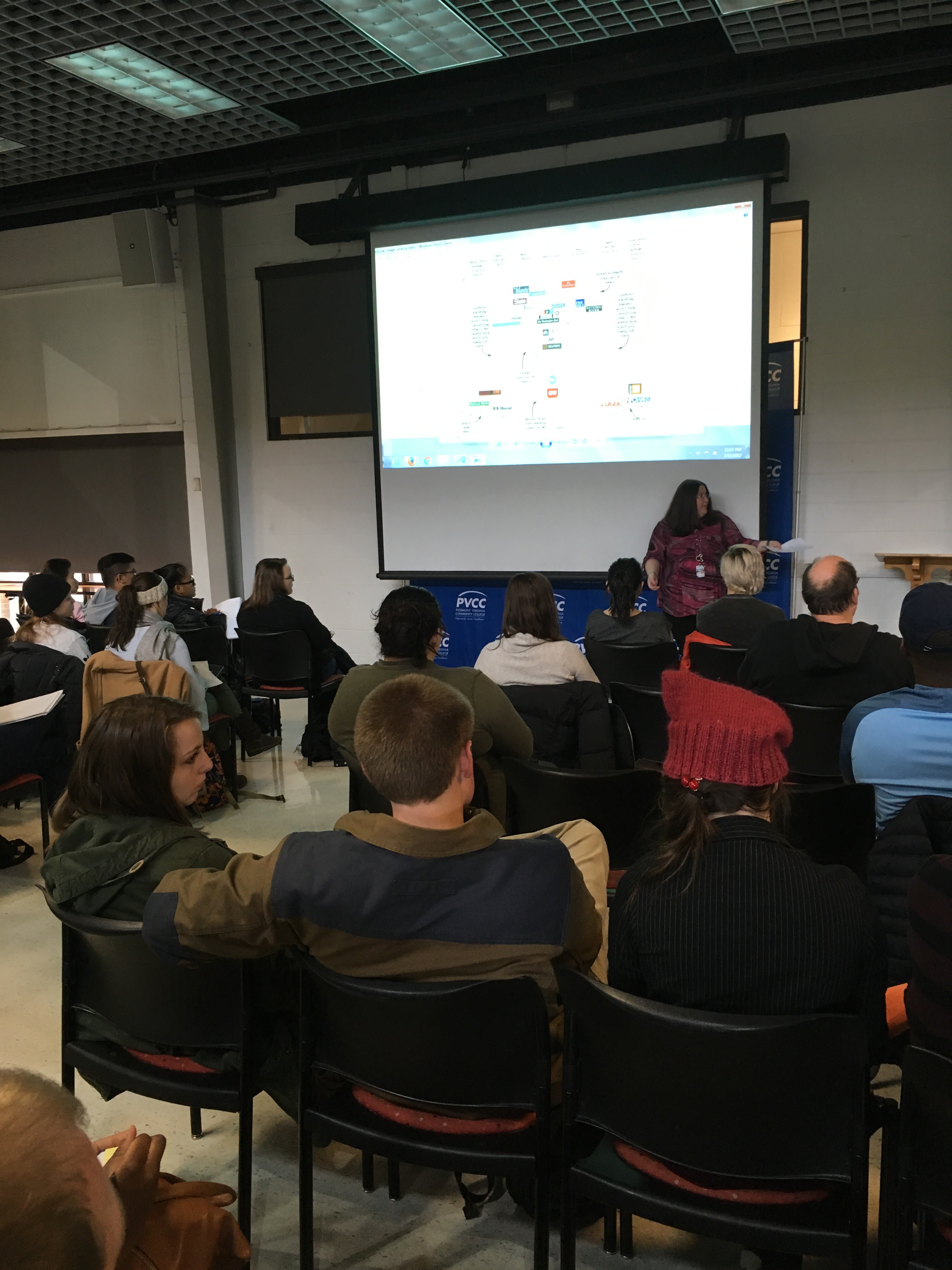
Fake News : Who Suffers the Most
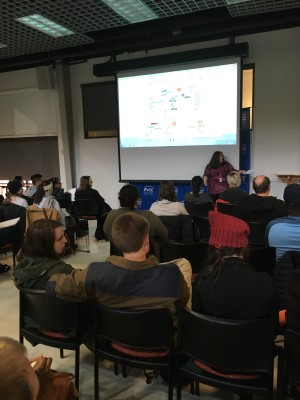
Joe Fowler, Charles Stish
A panel of three experts dedicated to finding truth, verifying sources and teaching others how to do the same, held a seminar to aid students in combating the escalation of fake news and the labeling thereof. The seminar took place in the North Hall Meeting Room in the Main Building of Piedmont Virginia Community College on March 15, from 12 – 12:50 p.m. The seminar, hosted by PVCC’s Psychology Club, detailed the issues and background information surrounding fake news.
Guest speaker, Dr. Katherine Allen who teaches Media Policy and Law and International Communications at UVA; Dr. Tamara Whyte, assistant professor of English at PVCC and the faculty advisor for PVCC’s student newspaper, The Forum; and PVCC Coordinator of Library Services Crystal Newell presented the facts and information.
Students and faculty filled the chairs in the large room. More attendees stood lining the walls. Many students had their laptops, smart phones, and pen and papers ready to jot down notes and observations as soon as the presentation began. The atmosphere was one of angst and focus, as the participants were ready to learn in-depth about the fake news phenomenon.
Allen spoke first, focusing on the definition of fake news and the dangers of potential censorship if individuals incorrectly defined fake news. “We are starting to define and make fake news incredibly broad. If we just talk about what is completely fake, and this is a complicated issue anyway because who is to decide what is fake and not fake, who is to decide what is right and wrong when we start figuring what’s fake and what’s not fake,” she said.
Arguably one of the biggest problems about fake news is how people can claim anything to be fake, immediately making others question the authenticity of the information they are reading, and as Allen said, who is to correctly define what is fake and what is truth? During her allotted segment, Allen stated both The New York Times’ and Politifact’s definition of fake news. The New York Times defines fake news as, “Fictitious articles deliberately fabricated to deceive readers, generally with the goal of profiting through clickbait, through advertising.” Politifact states that fake news is “fabricated content designed to fool readers and subsequently made viral through the internet to crowds to increase its dissemination.”
Allen agreed with these definitions and said, “When we are thinking about it, fake news should only apply to stories that are completely made up and disseminated for profit.”
After defining fake news, Allen began to describe some of the forms of speech that are commonly misperceived and labeled as being fake news despite being protected by the First Amendment of the United States of America’s Constitution. These protected forms of speech are: artistic speech (paintings, satire, movies, etc.), religious speech (promoting or discussing religious belief), hate speech (opinion), political speech (expressing political views), and pornography. The First Amendment does not protect seditious/treasonous speech, obscenity (excessively offensive sexual content), aggressive and inflammatory words (insults about race or gender), blackmail, extortion, perjury, and child pornography.
By creating an objective definition of fake news that follows the law of the First Amendment, Allen helped establish that people can still be biased, artistic, or political without being censored, fined, or jailed, by being labeled as fake news. Allen expressed concern about the idea of censoring fake news due to potential threats to the First Amendment.
After Allen, Whyte gave her part of the seminar. For her presentation, Whyte discussed how honest and non-partisan media outlets, such as The New York Times, the British Broadcasting Company, National Public Radio, and the Associated Press, and their reporters are fighting and struggling against the fake news social epidemic. Whyte said, “There are two points I want to make. First, not all journalists are trying to trick you. And second, is that we should not conflate fake news with satire, sloppy reporting, and partisan bias. We should want to define fake news by the part that people were originally talking about with fake news, as a news source that is intentionally trying to trick people.”
She then continued with, “So one of the big problems with labeling fake news is that people are labeling anything they don’t agree with as fake news and most journalism is not fake news. 99% of what you’re going to encounter is not fake news. In fact, most journalists are actively pursuing truth and attempting to inform the public.”
Whyte then recited the code of ethics for the Society of Professional Journalists, which reads : “Members of the Society of Professional Journalists believe that public enlightenment is the forerunner of justice and the foundation of democracy. Ethical journalism strives to ensure the re-exchange of information that is accurate, fair, and thorough. An ethical journalist acts with integrity.”
After this, Whyte explained that most mainstream media outlets strive to follow these guidelines as it protects the outlet’s viability, accuracy, and reliability in distributing information. She even said some mainstream sources have fired employees for violating these guidelines.
On a large projector screen, Whyte displayed a diagram of often-referred to, and well- known, news sources. The diagram, going from left to right, showed the extremist left-winged sources (Natural News, U.S Uncut), companies with a somewhat left-wing bias (The Huffington Post, The Atlantic), unbiased, non-partisan outlets in the middle (BBC, NYT, NPR, AP), somewhat right-winged biased outlets (Fox News, Wall Street Journal), and then the extremist right-winged ones (The Blaze, Daily Caller).
While Fox News, the Wall Street Journal, The Atlantic, and The Huffington Post might have a hint or at least a noticeable bias, this does not mean they are bad or disreputable sources of information. Readers should be more cautious and wary of the content especially when compared to unbiased sources such as BBC and AP, who have little to no partisan bias. Whyte said, “Knowing the basics about the organization can help you a lot to be critical of what they’re saying.”
Before the end of her segment, Whyte added two more important notes. The first one being not to share stories online before reading them. As an example of this problem, she referred to The Huffington Post’s article “Bernie Sanders Could Replace President Trump with Little-Known Loophole.” This article’s headline and first-paragraph were intentionally created to satirize fake news and misinformation that is flooding the internet and our daily lives. Especially when people tend not to read the article, but instead share it without reading. The Bernie Sander’s article was no different. It was shared on viral levels to social media before people realized it was a critique on exactly what they were doing, sharing but not reading.
Whyte’s second point was how the 24-hour news cycle is encouraging bad reporting and news gathering since many companies are aiming to be the first ones to report a situation or event. This tends to make truthful details and information less of a priority that reporters can fix later.
After Whyte concluded her presentation, Newell spoke on the importance of identifying accurate information through research and fact checking. Just recovering from laryngitis, Newell persevered and gave her presentation in a display of commitment to facts. Newell began by asking, “How many of you have actually shared, through whatever means, an article without reading it?” In a show of honesty, Newell, Whyte, and Allen raised their hands, showing they are guilty of sharing an article without reading it.
In her segment, Newell gave ways to help people identify the accuracy and viability of information. Using Twitter and tweets as an example, she said, “So, one thing that you should recognize when you’re reading a tweet on Twitter is whether that tweeter has suddenly appeared out of nowhere. Like, you click on that person’s account and you go, ‘Oh my gosh, they are only five tweets from this person within the last 24 hours.’ Run, okay? Run.”
Newell then explained that a research study conducted by Stanford University showed most people, when presented with a Tweet that had an embedded link, would immediately decide if the information was true or fake. She then asked the crowd what they would do first when presented with the same situation. An answer came back; they would click the link. Newell responded energetically, “Click the link! 80 percent of the people who were participating in the study did not click the link. So, they didn’t even read the link.”
“What was the other thing? I just said it.” Check the source was the answer she received. Newell verified its correctness by stating, “Click on the tweeter and see who it is. If that person just showed up 25 minutes ago, run.”
Newell went more in depth by describing the different methods of identifying and judging different types of information.
These methods included: checking the evidence in the source (source attributions, information accuracy, wording of information e.g. “I believe…”), checking the date of the source (meaning, is the information still relevant?), finding the source publication (where did it come from? The Blaze? AP?), and finally verifying an emotional response. The last point is identifiable by whether the article tries to emotionally sway the reader to feel a certain way. Newell concluded with, “If you read, if you click, and honestly, if you’re just a little bit skeptical, or as Allen said, be a little bit cynical, then you’ll be okay.”
Once all three speakers gave their presentations, the floor opened for questions from the audience. After a brief period of silence, the first question came from a reporter in the crowd who asked about the idea of greater transparency from those reporting the news.
Whyte said she teaches her journalism students to reach out and work harder, especially with the claims of fake news from many angles. “I think it’s a good idea,” Whyte said.
Allen was less enthusiastic, saying even though ethics might lead journalists to become more transparent, the corporations that run many media outlets probably would not approve of the idea. Allen, Newell and Whyte then had an open exchange about how a handful of corporations controlled much of the media in the United States.
After Allen said she relied more on international media sources because of the amount of corporate involvement in American media, another attendee asked how to find reliable and objective facts. All three speakers engaged in a conversation in favor of news agencies like Al Jazeera, BBC and NPR.
One of the tips Newell suggested was reading articles that go against one’s own bias as a means of understanding as many angles on a story as possible. So far as corporate media sources, she simply said, “You’re not going to escape it,” and she reiterated the importance of reading from a wide range of sources along with fact checking.
The seminar began wrapping up at that point because it ran over the allotted time. Decades of experience and wisdom melded with a certain degree of cynicism to match. Allen, Newell and Whyte presented the truth, facts figure and statistics in an understandable fashion.
The final question from the audience was more of a statement than anything else. A young woman said, “We’re already working so hard and you’re asking us to work more.”


